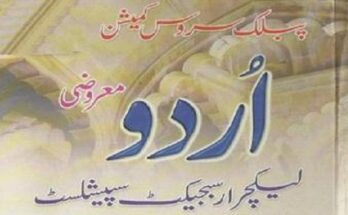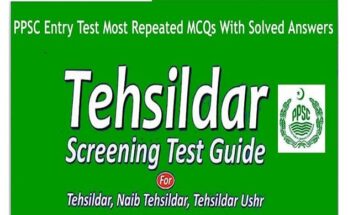PPSC Test MathMatics MCQs 2019 Withfull Book Download in PDF
NUMBER SYSTEMS BASIC RULES
• The closure property of real numbers under addition states that the sum of two real numbers Is also a real number.
• The commutative property of real numbers under addition states that the sum of NO real numbers is independent of the order In which they are added.
• The associative property of real numbers under addition states that
a+(b+c)=(a+b)+c ‘Va,b,ceR.
• For each a e R there exists an element – a e R such that a +(-a) = 0 = -a +a . The
element -a Is called the additive inverse of the real number 8.
• The closure property of real numbers under multiplication states that the product of two real numbers is also a real number.
• The commutative property of real numbers under multipfteation states that the product of two real numbers is Independent of the order in which they are multiplied.
• The associative property of real numbers under multiplication states that
a(bc) = (ab)c ‘V a,b,c e R.
• The left distributive law for multiplication over addition states that
a(b+c)=ab+ac rta,b,ce R.
• The right distributive law for multiplication over addition states that
(a+b)c = ac+bc rta,b,c e R .
• The trichotomy property of real numbers states that for real numbers a and b, exactly one of the following
• If a< band c <d, then a+ c < b +d. This is known as additivity.
Multiple Choice Questions
1. Ois
(a) an odd integer (b) an irrational number
(c) a natural number (d) an even integer
2. 3is
(a) an odd integer (b) an irrational number
(c) a rationalnumber (d) a negative integer
3. J3 is
(a) an irrational number (b) a rational number
(c) a natural number (d) a negative Integer
8. Every odd Integer is also
(a) rational number (b) negative integer
(c) positive integer (d) irrational number
9. .Every even integer is also
(a) natural number (b) Irrational number
(c) rational number (d) whole number
10. If n is a prime,then fn Is
(a) rational number (b) whole number
(c) natural number (d) irrational number
11. If n is a perfect square, then fn is
(a) an Irrational number (b) a rational number
(c) always an even integer (d) always an odd integer
12. 1r is
(a) a whole number (b) a natural number
(c) a rational number (d) an irrational number
13. Every recurring decimal or terminating decimal represents the
(a) rational number (b) irrational number
(c) natural number (d) integer
14. Every non-repeating non-terminating decimal is
(a) rational number (b) irratiOnal number
(c) integer (d) none of these
15. The addiUve identity of real numbers is
(a) 0 (b) 1
(c) 2 (d) 3
31. The set {0} has
(a) closure property with respect to multiplication
(b) not closure property with respect to addition
(c) not closure property with respect to multiplication
(d) closure property with respect to division
32. Which of the following sets has closure property with respect to addition?
(a) {-1, 1} (b) .{-1}
(c) {l} (d) {0}
69 Z is a group under
(a) subtraction (b)diviSion
(c) multiplication (d) addition
70 The action of wearing soc:Ks and shoes
(a) do not oommute (b) oommute
(c) does not exit (d) is associative
71 The set of all non-singular matrices of order 2 fonns a non-abelian group under
(a) addition (b) subtraction
(c) multiplication (d) division
72 A closed set with respect to some binary operation is called the
(a) group
(b) commutative group
(c) groupoid
(d) non·ablllan group
73 A non-empty set which is closed with respect to some binary operation is called the semi· group If
(a) the binary operation is associative
(b) the binary operation is oommutative
(c) the binary operation is anti-commutative
(d) Identity element exists
DIFFERENTIATION
• The composition I o g of two functions fand g is defined as (I o g)(x) = l(g(x))
• If g is differentiable at the point x and fis differentiable at the point g(x), then the composition I o g of these functions is differentiable at x and (f o g)'(x) = l'[g(x)].g'(x)
• ‘If a.,apa 2 ,a3 ,a4 , …an,… are constants and xis a variable, then the series of the form a. +a x+a x 2 +a x 3 +a x 4 +…+anxn +… lscalledapowersene.s
• If a function f is defined at 0 and its all derivatives at 0 exist, then the Maclaurin’s series expansion of the function f is xl x3.xn l(x) = I(O)+xi'(0)+ -1″(0)+-1″‘(0)+…+-11″>(0)+…
2!
• If a function fls defined at a point a and its all derivatives at sexist, then the Taylor’s series expansion of the function f Is
• Geometrically the derivative of y at x represents the slope of tangent at the point P (x,y) .
• A function r defined on an interval [a,b] is said to be inaeasing function on [a.b] if
x1 <x2 => l(x1 ) <l(x2 ),where x1 andx2 areanynumbersintheinterval [a,b] .
• A function f defined on an Interval [a,bI is said to be decreasing function on [ a,b1 if
X 1 < X2 => l(x1 ) > f(x 2 ), where x1 and x2 are any numbers in the interval [a,b] .
• Let the funcbon f be continuous on the closed interval [a,b] and differentiable on the open interval (a,b) ,then f is Increasing on [a,b] if I'(x) > 0 for all x in (a,b) .
• Let the funcUon f be continuous on the closed interval [a.b1 and differentiable on the open interval (a,b),thenfisdecreasingon [a,b] If l'(x)<O torallx1n (a,b).
• The function f is said to have a relative maximum value at c if there exists an open Interval containing c, on which fls defined,such that f(c) 2: l(x) for all x c In this lotervaJ.
• The functlon f ts said to have a relabve m1namum value at c if there eXists an open interval oonta10ing c, on YAliCh f 1s defined,such that I(c) I(x) for au x * c in this interval
• If c is a number in the domam of the function f and if either I1(c) = 0 or I1(c) does not exis then
cis called a aitical number and the point (c.l(c)) is called the cntical point.
ANALYTIC GEOMETRY
• The medians of a triangle are concurrent and that the point ot concurrency divides each one of them in the ratio 2:1.
• The point of concurrency of the medtans ot a triangle is called its centroid.
• The angle bisectors of a trial’gle are concurrent
• The point of concurrency of the angle bisectors of a triangle is called 1ts in-rentre.
• Inclination of a non horizontal lin•e /Is the angle a, 0 < a < 180″ positive x-axis to I.
• If a is the incl1nation of a non-vertical line 11 then its slope or gradient is tan a .
• If a line intersects x-axis at po1nt (a,0) then a is called the x-mtercept of the kne.
• If a line Intersects y-axis at point (0, b)Ithen b is called the y-lntercept of the line.
• The equation of a non-vertical line with slope m and y-intercept cIs y = mx +c .
• If p is the length of perpendicular from origin to the non-vertical line I and a Is the lrfcllnation of P then show that the equation of the line is x cos a +y sin a = p .
• The general equation of a str319ht hne is ax +by + c = 0Iwhere either a 0 or b 0 .
• Thelines a1x+b1y+c 1 =0 a2 x+b2 y+c 2 =0 areperpendicularif a,a2 +b1b2 =0
• The lines a,x +b,y +c, = 0 I a2 x +b2 y +c2 =0 are parallel if a,b2 -a2 b, = 0 .
• Parallel lines never 1ntersect each other.
VECTORS
• A scalar Is a quantity having magnitude but no direction,e.g.mass, length, time, temperature, density, distance,area,volume, and any real number.
• A vector is a quantity having both magnitude and direction, such as displacement. force, velocity, acceleration ,and weight
• The magnitude of a vector is always nonnegative number.
• The vector whose magnitude is one is called the unit vector.
• The vector of zero magnitudl! is called the null vector or zero vector.
• Two vectors A and lJ are said to be equal vectors if they have the same magnitude and same
direction regardless of the position of their initial points.
• The vectors intersecting at a single point are called the concurrent vectors and this point where the vectors Intersect Is called the point of concurrency .
• The vectors lying in the same plane are called the coplanar vectors.
• The resultant of two vectors acting along the adjacent sides of a parallelogram is the diagonal of the parallelogram.
• A vector whose Initial point is at origin and whose terminal point Is PIs called the position vector of point
P.
• The diagonals of a parallelogram bisect each other.
• If a vectcr r makes angles a, p, y with x-axis,y-axis, z-axis respectively, then these angles are
called the direction angles of the vector !:.
• If a vector !: makes angles a ,p, y with x-axis, y-axis, z-axis respectively, then
cosa , cos p, cosy are called the direction cosines of the vector r .
• The scalar product is commutative .
ah
• The projection of a vector along a vector £ is – .
• Scalar biple product will is zero if any two of Its vectors are equal.
• If the vectors a and b act along the adjacent sides of the parallelogram, then tJ:le area of the parallelogram Is Ia X bI·

Post Views: 2,298





